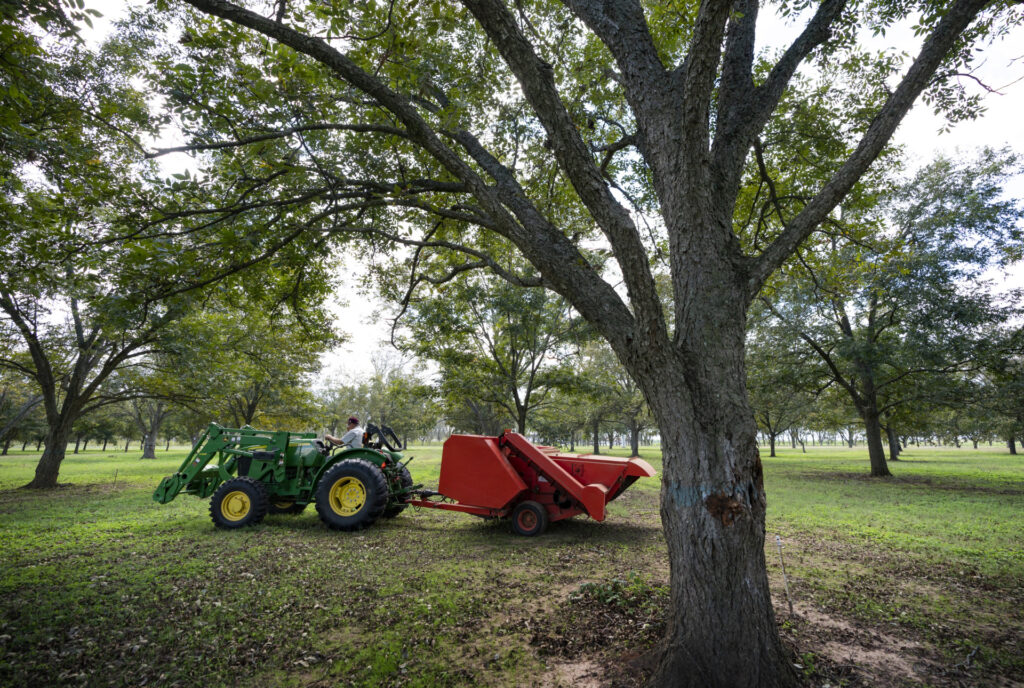2023 update on Texas pecan production, prices and pests
Texas Crop and Weather Report – Sept. 12, 2023
Although prices remain steady, consumers should pay extra attention to early pecan harvest production, according to a Texas A&M AgriLife Extension Service expert.

Larry Stein, Ph.D., AgriLife Extension horticulturist, Uvalde, said pecan production in some regions of the state is looking positive, thanks to water supplies available for irrigation, but the drought is still playing a significant role in the quality of this year’s pecan harvest.
Pecan production affected by the drought
Certain areas in Texas have experienced rainfall that has allowed pecan production to continue as usual. One of those areas is Far West Texas, including around El Paso. This area has continued pecan production as expected since it received rainfall, creating ample water supplies for irrigation systems to pull water from the river.
Other areas without enough water supplies for irrigation have lost some of their crops due to trees dying.
“Now is the prime time to pull the kernel inside,” Stein said. “But we aren’t sure how well the later crop will turn out.”
Producers have noticed that early native pecan varieties such as Pawnee, Mandan and Eclipse have started opening up, and these varieties look exceptional.
Pecan pricing
Although prices of other crops have gotten higher this year, the cost of pecans is not expected to increase from the previous year’s prices of $2 to $3 per pound for in-shell pecans and $4 per pound for shelled pecans.
Consumers preparing to purchase pecans from this harvest should expect to see availability from late September to early October.
“Consumers might be better off purchasing the early harvested pecans since we don’t know the outcome of the varieties that will open later in the season,” Stein said.
Pecan pests
Due to dry conditions, pests that usually attack pecan production have been minor, Stein said. During the earlier months of production, producers sprayed for the yearly summer pests, but pests didn’t have much impact on production.
Producers have reported that the black and yellow aphid populations have been minimal this season.
“The drought is a blessing in disguise for pecan producers,” Stein said. “This year’s drought has reduced the number of pests we have seen.”
AgriLife Extension district reporters compiled the following summaries:
Central
Exceptional drought conditions continued with another week of record high temperatures, which were 10-15 degrees above normal in most areas. There were heavy rains throughout the district, which brought anywhere from a third of an inch to 3 inches, as well as cooler temperatures. Tanks that were not already dry continued to dry up. Pastures were extremely dry, and tree conditions declined. One county reported that the corn harvest was halted due to high yields, high acres and full grain bins. Producers feared hay wouldn’t make another crop this year. The cotton harvest neared completion, yielding around a third to a half bale per acre. Producers started thinking about planting oats for grazing but will have to wait for additional rainfall. Winter wheat planting was delayed until later in the fall to avoid as much of the first flush of Hessian flies as possible. Cattle prices remained good, along with sheep and goat prices. Livestock were being heavily supplemented.
Rolling Plains
Extreme heat and dry conditions persisted last week. Cotton across the entire district was reported as poor or completely burned up. Many cattle producers continued thinning their herds, selling as many as possible to reduce the amount of hay and supplements being fed. Some farmers started to dry-sow wheat and apply fertilizer in anticipation of forecasted rains. All counties were hopeful for the projected moisture and cooler temperatures.
Coastal Bend
A few areas reported isolated storms bringing less than a half inch of rain. Some damaging winds were reported in Wharton County. High temperatures and lack of additional rain dried out most fields, allowing producers to continue stalk destruction and preparing the soil for the growing season. Most cotton harvest was completed. Some rice fields were being irrigated for the ratoon crop. Wharton County reported rice acreage was down 40% from last year due to unavailable surface water for irrigation. More than 20,000 acres of rice were reported as prevented planting in 2023 due to unavailable irrigation water. Livestock producers continued culling herds and selling calves due to poor pastures and limited water availability. Some cattle producers tried to feed their way through the drought with hay and protein supplements. Pasture conditions were poor, and hay supplies were critically low. Hay was costly, if it could be found. Livestock markets continued holding firm, even with higher numbers of cattle selling.
East
Some counties received small amounts of rainfall. Angelina County reportedly received as much as 4 inches in some parts over the last two weeks. The majority was still under severe drought stress. Ponds and creeks were shallow. Pastures and rangeland conditions were poor to very poor. Subsoil and topsoil conditions were very short. Jasper County reported wildfires were still occurring regularly. Producers scrambled to find hay or to sell cattle at the market. Market prices remained strong despite the increased numbers being sold. Livestock were in fair condition with continued supplemental feeding. Armyworms were reported in Harrison County.
South Plains
Extremely dry conditions continued across the county. Most dryland cotton was not expected to make a crop this year due to the lack of rainfall and extreme heat. Pumpkin harvest started a couple of weeks ago. Producers have been busy harvesting corn and sorghum silage over the past few weeks. Estimates for irrigated cotton harvest ranged from 1 bale to 2 1/2 bales per acre. Pasture grazing was depleted due to the lack of rainfall, and a few producers were supplemental feeding cattle. Cattle were reported to be in good condition.
Panhandle
Hot and dry conditions prevailed over the region. Some areas received a small amount of rainfall, but more was needed to help. Dryland cotton was nearing completion; acres had turned brown, and bolls had started to open. Irrigated cotton looked good, but with not enough rain and then too much rain, the crop was not expected to be the best in terms of grades or quality. Pasture grasses have gone dormant due to excessive heat and lack of moisture. Producers fed hay as quickly as possible, some taking it straight from the fields as soon as it was bailed. Some producers were concerned this would cause a hay shortage this winter. Producers were waiting to plant small grains due to the lack of moisture.
North
Drought conditions continued with temperatures over 100 degrees. Topsoil moisture ranged from short to very short. Corn harvest was completed, and most counties reported high yields. Soybeans and sorghum were harvested as well. Livestock were doing well.
Far West
There was another week of extremely hot conditions, with temperatures in the 100s. Scattered showers provided a few tenths of an inch in the northeastern and southwestern corners of the region. Cotton was maturing quickly, with some fields close to 100% open. A few areas had defoliants sprayed on them. Overall yields were expected to be well below average. Grain sorghum crops were expected to be a loss and not harvested. Fields were resting, with most kept in place to prevent wind erosion. Pastures were all brush, with no grass in sight. Hay was being fed to livestock regularly. Livestock were in poor to fair condition. Area beef cattle producers were in full swing of weaning/shipping season, but many were having trouble keeping livestock cool, hydrated and well-fed. Dove season started with large amounts of dove noted.
West Central
Small showers allowed temperatures to drop into the upper 90’s and 80’s. The forecast showed moderate chances of rain and cooler temperatures for the coming week. Some producers began field preparation for small grain planting, while others waited on rain so they could start plowing fields. Cotton crops and hay were in mostly poor to fair condition. Late-planted sorghum was struggling due to drought stress. Trees of all species were showing signs of drought/heat stress, with leaves browning and starting to fall. Some pecan producers were expecting pecan trees to struggle. Lake/stock tank water levels were dropping. Supplemental feeding of livestock increased due to the drought. Another cow herd sold out this week at a local auction barn.
Southeast
Multiple counties had scattered showers but were experiencing exceptional drought conditions. Rice was beginning to be cut after the small break due to the wet conditions during planting. Producers were hoping for one more hay cutting, but chances were looking slim. Cattle were brought to local auction barns as producers continued culling their herds due to the lack of grass/hay. Calf prices lowered slightly, but the market was still very favorable. Several tree species were hitting early dormancy due to the lack of rain; some showed drought stress. Grasshoppers continued increasing in numbers.
Southwest
Hot and dry conditions persisted, with daytime temperatures exceeding 100 degrees for most of the week. Some areas reported scattered showers for the weekend, from minimal measurable accumulations to about one-fifth of an inch of rain. The pecan yield was expected to be low during harvest, even among irrigated orchards. The few signs of green grass were shrinking; the only green grass left was in shaded areas of trees and structures. There was an estimated 3% loss of trees and shrubs in pastures, and many live oak trees turned brown. Water well companies were working tirelessly, lowering pumps in wells if possible. Pastures were browning quickly. Rangelands and pasture conditions had deteriorated to necessitate supplemental feeding. Cattle operations continued thinning herds to cut feed costs. Livestock and wildlife were still in good condition with supplemental feeding. Livestock markets looked surprisingly strong and were in mostly fair condition. Dove hunters were pleasantly surprised with the number of doves seen this week.
South
Conditions remained extremely hot, dry and humid. Cotton was struggling due to the extreme heat. Most producers who had already harvested their cotton crops were in the process of stalk destruction, while others were building up rows for future crops. The sesame crop was flowering and looked decent overall. In some counties, forages improved significantly in rangelands and pastures, but reports of hay harvesting still needed to be received. Beef cattle markets slowed in volume but continued to report solid prices for all classes of beef cattle. An abundance of doves were reported in the district as the first weekend of white-wing hunting opened.





